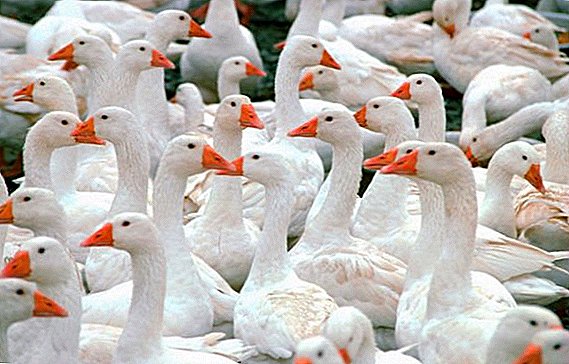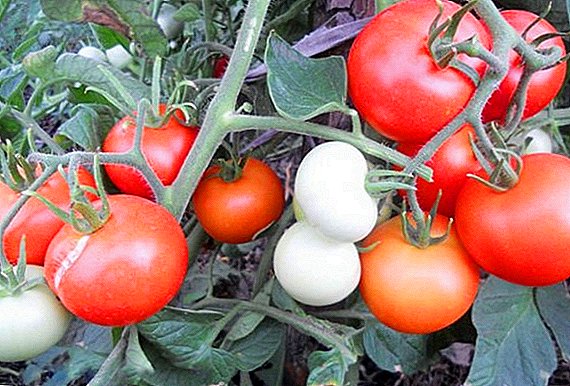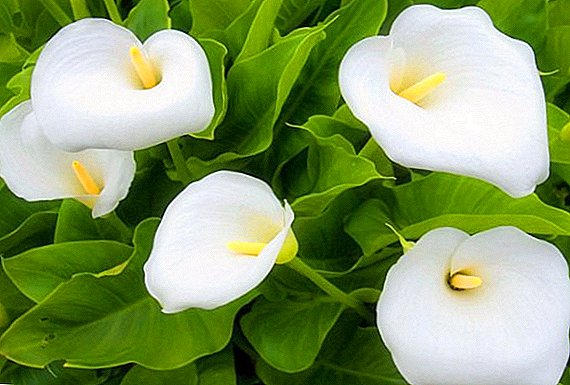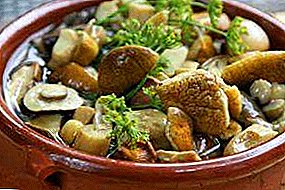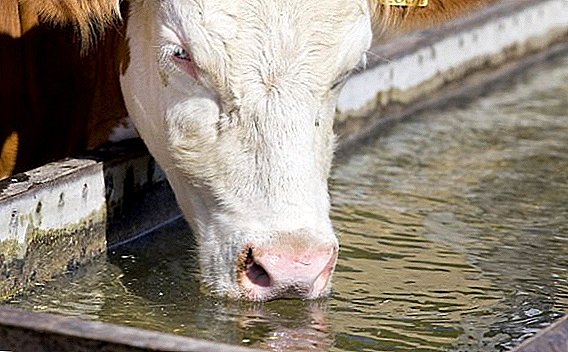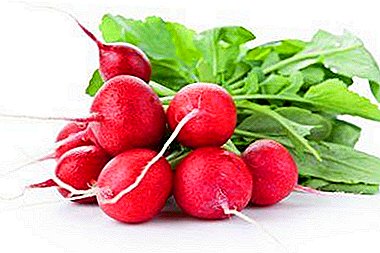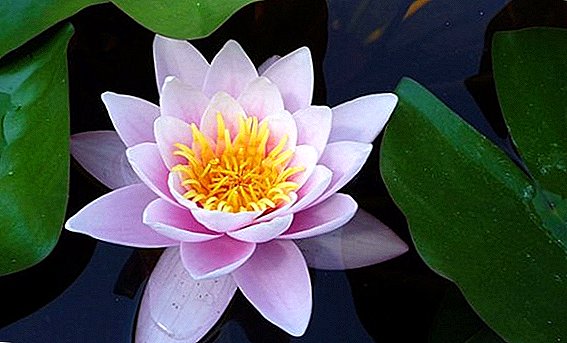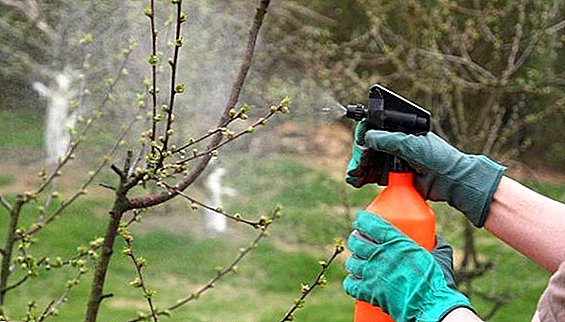 If someone thinks that by planting an apple tree at his dacha, he is guaranteed to provide himself with an abundant harvest of apples for the rest of his life, then one can be greatly disappointed.
If someone thinks that by planting an apple tree at his dacha, he is guaranteed to provide himself with an abundant harvest of apples for the rest of his life, then one can be greatly disappointed.
Planting a tree (as well as the birth of a son) is only the first small step on a long path that you have to go through before the first results of your labors make themselves known. A tree, like a child, must be taken care of constantly, otherwise diseases and pests can cause irreparable harm to your offspring.
Why you need to spray trees and shrubs in the spring
The beginning of the season, that is, the period when garden trees and shrubs, waking up after the winter cold, begin to accumulate forces for the formation of fruit mass - this is the time when you need to take care of their protection as much as possible. That is why Treating trees in the spring against pests and diseases is an important step in garden farming.
In fact, spring is a cunning period. On the one hand, the tree needs time to recover after a long stay in extreme conditions of severe frost, on the other - various pests, having also recovered from hibernation, begin to actively feed on, eagerly attacking barely opening leaves and flowers. It is not surprising that the care of trees in the spring includes the obligatory treatment of pests, because if you do not intervene in the process, you can not wait for the harvest. Of course, it will not be possible to destroy all harmful insects in the garden, although such a task is not set. It is much more important to ward off unwanted guests from the garden, to make your trees and shrubs as unattractive as possible for such pests, both in terms of food and in terms of "living."
 Another important argument in favor of spring processing of the garden from pests and diseases is that this period excludes the direct impact of toxic chemicals on the ovaries and fruits (simply because they have not yet formed), therefore, the pest control in the spring minimizes the risk of subsequent poisoning with such drugs as a result of eating processed fruits and berries.
Another important argument in favor of spring processing of the garden from pests and diseases is that this period excludes the direct impact of toxic chemicals on the ovaries and fruits (simply because they have not yet formed), therefore, the pest control in the spring minimizes the risk of subsequent poisoning with such drugs as a result of eating processed fruits and berries.
In this way, The main task of spraying the garden in spring is to prevent pests and diseases that will lie in wait for your plot throughout the season, including when the use of fungicides and insecticides will negatively affect the ecological cleanliness of the crop.
Of course, ideally, we all want to boast of fruits and berries grown "without chemistry." However, it is very important to maintain a healthy balance and sense of proportion. Breeders around the world are struggling to create resistant to one or another disease plant varieties, but to bring out completely immune to harmful external influences, the species has not yet been possible, and it is hardly possible at all, since the very nature of the scheme, in which "everyone eats everyone ". Therefore, we should expect that the fruits of the tree, which does not infect any pest, will be inedible for humans, because we are also part of the animal world.
 In addition, even if the manufacturer assures you that this particular variety (for example, an apple tree) is absolutely not affected by scab, it is worth treating such statements with a fair amount of skepticism. And this does not mean that they are deceiving you. The fact is that the development of certain diseases, like the spread of various pests, depends largely on the specific external conditions that are constantly changing. In addition, insects and carriers of infectious diseases tend to mutate and adapt to new realities. No wonder they say that the same fungicide cannot be used in the garden - the preparations must be constantly changed to ensure the best result.
In addition, even if the manufacturer assures you that this particular variety (for example, an apple tree) is absolutely not affected by scab, it is worth treating such statements with a fair amount of skepticism. And this does not mean that they are deceiving you. The fact is that the development of certain diseases, like the spread of various pests, depends largely on the specific external conditions that are constantly changing. In addition, insects and carriers of infectious diseases tend to mutate and adapt to new realities. No wonder they say that the same fungicide cannot be used in the garden - the preparations must be constantly changed to ensure the best result.
The main enemies of fruit trees, against which the spring spraying is directed, are caterpillars, butterflies, various beetles and aphids. So, if you do not spray the apple tree at the very beginning of the season, the aphid begins to actively suck the juice from greenery and flowers, and also deforms the bark of the tree, forming ugly growths on it, which then crack and turn into gaping wounds. As a result, the tree may stop developing and die. The same danger lies in wait for pears, plums, apricots, cherry plums and other fruit trees.
Maycha likes to eat leaves and ovaries, and his favorite delicacy is the plum tree. While the adult is rampant on the surface, its numerous larvae infect the root system of trees, which is especially dangerous for young seedlings. Timely spraying can help rid the garden of such misfortune.
 Caterpillars and butterflies are also happy to eat greens and fruits of apples, pears, plums and cherries, so the protection of such trees, carried out in the spring, will preserve the future harvest.
Caterpillars and butterflies are also happy to eat greens and fruits of apples, pears, plums and cherries, so the protection of such trees, carried out in the spring, will preserve the future harvest.
The above fully applies to the treatment of shrubs (black and red currants, gooseberries, raspberries, etc.), since it is in the spring that basic measures need to be taken to protect all plants from pests and diseases.
How to spray the trees in the spring of diseases and pests
Currently, there are plenty of options than to treat fruit trees from pests in the spring. Conventionally, they can be divided into three groups:
- biological preparations;
- chemicals;
- "improvised" means, which are usually used by ardent opponents of the first two options, considering this method safer for health (and, of course, more economical).
Biological agents
Biological garden treatment products are becoming increasingly popular as a direct alternative to chemistry.
Their effect on harmful insects and disease carriers is not exerted by artificially synthesized toxic substances, but by living organisms (bacteria, bacterial viruses, antagonist fungi, and even insects). Also, as an alternative, not the living being itself is used, but the toxin (biotoxin) secreted by it.
Did you know? Living organisms that destroy insect pests are called "entomophages". Separately produce acarifagi - killer mites. Akarifagi can act differently: predators such as dragonflies, thrips, bedbugs, flies, and various beetles devour ticks. Unlike predators, other organisms (parasites) penetrate into the pest, feed at its expense, which ultimately leads to the death of the "victim".
 Such biological agents can be “wound up” on the site independently, creating conditions that attract beneficial insects. This role can fulfill, say, mustard, buckwheat, dill and other honey plants planted in the country. However, for reliable protection of the garden, such preventive measures are usually not enough, so scientists have developed numerous preparations based on the action of beneficial organisms. Consider some of them.
Such biological agents can be “wound up” on the site independently, creating conditions that attract beneficial insects. This role can fulfill, say, mustard, buckwheat, dill and other honey plants planted in the country. However, for reliable protection of the garden, such preventive measures are usually not enough, so scientists have developed numerous preparations based on the action of beneficial organisms. Consider some of them."Trikhodermin" is an excellent antagonist of a number of pathogenic fungi (including pathogens of scab, various types of rot, late blight and other unpleasant diseases). The plant itself does not experience any harm from the action of Trichoderma, on the contrary, this fungus releases substances that make the plant more resistant to the corresponding diseases. Treatment with the drug can be carried out from the moment of bud break and continue throughout the season.
"Planriz" is a soil bacteria that protects the garden from powdery mildew, root and root rot, leaf rust, septoria (often infecting raspberries), as well as lepidopteran pests.
"Pentafag" - A proven way to prevent diseases of fruit crops with bacterial cancer, and damage to stone-hole perforated spotting. In addition, it is a good prevention of scab and powdery mildew.
"Phytodoc" inhibits the development of pathogenic fungi and bacteria, in particular, protects fruit trees from late blight, bacterial cancer, root and fruit rot, mold, powdery mildew, fusarium wilt, etc.
 "Fitosporin-M" It protects the garden against fungal and bacterial diseases such as scab, wilt, late blight, root rot, powdery mildew, brown rust, and others.
"Fitosporin-M" It protects the garden against fungal and bacterial diseases such as scab, wilt, late blight, root rot, powdery mildew, brown rust, and others.
"Mikosan" protects fruit trees from fungal, bacterial and viral diseases. Its action is based on covering the organs of the plant with a protective film that does not allow the pathogen to hit them. The drug strengthens the immune system of the tree and helps it to cope with the disease itself. This tool should be used separately from any other drugs, in the calculation of 0.1 kg of the substance in 4-8 liters of water.
"Gaupsin" proved to be an effective remedy against aphids, codling moth, leafworm, cherry and plum flies. Of the diseases, the zone of influence of the drug is powdery mildew, late blight and others. It also nourishes the plant with the necessary nitrogen for it.
"Bitoxibacillin" also well protects the garden from gnawing and lepidopteran pests (spider mites, cabbage moths, haws, silkworms and others). Its action is based on the violation of the intestinal function of the insect, as a result of which the larva dies.
"Actofit" kills caterpillars, ticks, whiteflies, aphids.
 "Riverm" It provides protection against various diseases of the fungal character and, just like Gaupsin, releases nitrogen molecules from the air. A distinctive feature of the drug is its very fast, compared with other biological means of protection, the effect (the root system of the tree, the active substance reaches less than half an hour after spraying).
"Riverm" It provides protection against various diseases of the fungal character and, just like Gaupsin, releases nitrogen molecules from the air. A distinctive feature of the drug is its very fast, compared with other biological means of protection, the effect (the root system of the tree, the active substance reaches less than half an hour after spraying).
Healthy Garden - Another tool to protect trees from aphids, moth, powdery mildew and other pests and diseases.
Tick and moth can help get rid of the drug "Fitoverm", from the caterpillars of the silkworm, moth, scoops, moths, cabbage, etc. - "Lepidocide".
"Nemabakt" - These are small roundworms that penetrate the larva and destroy it with lightning speed. Over the summer, these small parasites are able to completely clean out your garden of pests, overwinter and continue their useful "activities" from spring.
Biological agents have a number of unconditional advantages: they do not accumulate in the soil, do not harm the plant, and their consumption is much lower than that of other drugs. But there are some drawbacks. Basically, these formulations need much more time to achieve a beneficial effect, while the chemical poison acts much faster.
Important! The use of biological products can be started only when the average daily temperature is at least +10°C. At this time, the pathogenic bacteria and pests, which are the food of the organisms represented in the biological preparation, awaken and begin to develop. Otherwise, such biological weapons are powerless, so that the earliest garden processing can be carried out only with the help of chemistry.
Chemicals
Garden processing with chemicals (pesticides) is considered the most effective way to protect trees and shrubs from diseases and pests. 
Did you know? The word "pesticide" comes from two Latin words: pestis (infection) and caedere (kill). The concept of "pesticides" includes the following groups of poisons: herbicides - act against weeds, insecticides - against harmful insects, fungicides - against pathogens of fungal diseases, zoocides - against warm-blooded animals (for example, rodents). Most often, pesticides, as is assumed from their name, kill one or another pest, however there are also sterilizers that cause infertility, as well as growth inhibitors that suppress the development of insects.Modern pesticides act very quickly and retain their effect for a long time, but, unlike biologics, they can be addictive for pests.
As stated above, The treatment of plants in early spring does not pose a danger to human health or domestic animals, because after a certain time after application, most pesticides completely decompose. Another advantage of chemical preparations is that they dissolve well in water and are mainly sold in convenient for quick use packages.
At the same time, unlike biologics, the correct dosage of pesticides plays a crucial role: exceeding the recommended dose can cause damage to the plant (burn, lower pollen viability, destruction of pestles) and harm to the environment, while the "shortage" provokes the production of harmful immunity organisms to the corresponding poison.
Important! It is necessary to work with chemicals only as much as possible following the safety regulations, as the toxin can cause harm to humans and pets, not only being swallowed, but also through the skin and respiratory tract.It is best to carry out spring processing of trees and shrubs with special complex preparations, which are a mixture of fungicide and insecticide. In this case, the plant is simultaneously protected from both diseases and pests.
 A possible replacement for such a complex drug is ordinary urea. The first treatment of the garden in early spring is recommended to carry out a higher concentration of urea (urea), adding a little copper sulphate to the mixture. An additional advantage of this composition is its ability to slow down the awakening of the tree for a short time (for a week or two), and as a result, it is protected from unexpected frosts during flowering (this applies especially to plum trees).
A possible replacement for such a complex drug is ordinary urea. The first treatment of the garden in early spring is recommended to carry out a higher concentration of urea (urea), adding a little copper sulphate to the mixture. An additional advantage of this composition is its ability to slow down the awakening of the tree for a short time (for a week or two), and as a result, it is protected from unexpected frosts during flowering (this applies especially to plum trees).
After flowering, trees should be sprayed with a less concentrated solution of urea. Such processing will save the garden from aphids, leaflets, apple flower beetles, and crayfish.
An overdose of urea can lead to the formation of burns on the sheet plate, therefore, diluting the urea with water, you need to be extremely careful.
Spring spraying of fruit plants with copper sulfate is also popular. The procedure is carried out in early March, before the appearance of the first buds, since this pesticide causes a burn in young leaves to achieve the concentration effect. An exception is the situation when it is necessary to disinfect a wound on the tree.
Copper sulfate has a detrimental effect on the pathogens of curl, moniliosis, coccomycosis and nodulation, phyllosis, scab, and other diseases. The drug is recommended to treat plums, pears and apples.
Important! Copper sulfate is very poisonous! Therefore, it is necessary to prevent the drug or its residues from entering water bodies or other sources of water, as this can lead to the death of fish and animals and create serious health problems for people.Most often, copper sulfate is mixed in equal parts with lime. The resulting mixture is called Bordeaux liquid and protects the garden from most diseases and pests, while being relatively harmless.
 These and other copper-containing drugs, such as "HOM" (copper oxychloride), "Oxyh" (copper oxychloride and oxadisyl), etc. Trees and shrubs are well protected from fungal diseases, but they should be used no more than once a year. Therefore, if such a spraying was carried out in the fall, a different type of treatment should be selected in the spring.
These and other copper-containing drugs, such as "HOM" (copper oxychloride), "Oxyh" (copper oxychloride and oxadisyl), etc. Trees and shrubs are well protected from fungal diseases, but they should be used no more than once a year. Therefore, if such a spraying was carried out in the fall, a different type of treatment should be selected in the spring.
Until the buds have blossomed on the trees, they can be treated with iron sulfate. In addition to protection against pests, this drug has another function - it nourishes the plants with iron, which is necessary for their proper development, this is especially important for such trees with iron-bearing fruits like apples, pears and plums.
"Drug 30 V" with early spring spraying it is aimed at destroying pests that overwinter on the bark of fruit trees. First of all, it is a moth, a bug, an aphid, a whitefly, a scale and a false guard, a moth, a hedgehog, fruit mites. The drug forms a film on the bark that kills the larvae hiding inside and destroys insect eggs. The disadvantage of the pesticide is a very long period of disintegration, in connection with which the manufacturer warns against using it more than once every three years.
Some gardeners process the garden with diesel fuel, but this oil product has a very destructive effect on the ecosystem. Therefore, if you do not work at the car depot, where “shoe polish is just full of dough”, use less aggressive chemicals in the garden.But if they decided to take a chance, the drug, firstly, can be used very early (even before the kidneys swell), secondly, its concentration should be minimal, and to enhance the effect it is better not only to dilute it with water, but also to mix with other chemicals. There is one exception: diesel fuel can really help protect the apple tree or plum from rotting, for example, in case of formation of breakage.
Folk remedies
 For opponents of chemistry, we can recommend a number of folk remedies used for spring garden processing. Here, however, it should be noted that many plants that are harmful to pests, which form the basis for spraying, cannot be physically obtained in early spring. In this case, it is sometimes possible to use stocks that have been dried since last year, but if the “recipe” implies the presence of fresh grass, it can be used at later stages, and in early spring to protect the trees with chemistry. Actually, this approach looks quite logical: until the bud has blossomed, we use a more “heavy” and dangerous protection for the tree itself, and after the leaves open, flowering and the appearance of the ovaries, we use the “light version” as a “control shot”.
For opponents of chemistry, we can recommend a number of folk remedies used for spring garden processing. Here, however, it should be noted that many plants that are harmful to pests, which form the basis for spraying, cannot be physically obtained in early spring. In this case, it is sometimes possible to use stocks that have been dried since last year, but if the “recipe” implies the presence of fresh grass, it can be used at later stages, and in early spring to protect the trees with chemistry. Actually, this approach looks quite logical: until the bud has blossomed, we use a more “heavy” and dangerous protection for the tree itself, and after the leaves open, flowering and the appearance of the ovaries, we use the “light version” as a “control shot”.
For spraying the garden use such pest-tolerant plants as: sow thistle (it is recommended to take freshly harvested), chili bitter pepper (you can take dried), walnut (dry leaves), sweet and bitter nightshade (you need fresh tops of the stems with leaves, buds and flowers), tansy (dried inflorescences), wormwood (you can take dried), chamomile, pharmacy, Dalmat, Caucasian (you can take dried), sarsazan (you can take dried shoots), tomato tops (you can use dried or taken from last year’s compost), garlic (pounded cloves), pine needles, bird cherry (you can take dry branches leaves), Sophora listohvostnaya or tolstoplodnaya (dried herbs collected in time of flowering), tobacco (shag) and many others.
 The principle of preparation of the solution is about the same: the raw material is crushed, filled with water, infused and filtered. Proportions, if desired, can be spied on the net. In addition to herbal preparations, spraying is also carried out with a saline solution or a solution of superphosphate and potassium chloride (the latter helps to get rid of aphids and leaf-gnawing caterpillars).
The principle of preparation of the solution is about the same: the raw material is crushed, filled with water, infused and filtered. Proportions, if desired, can be spied on the net. In addition to herbal preparations, spraying is also carried out with a saline solution or a solution of superphosphate and potassium chloride (the latter helps to get rid of aphids and leaf-gnawing caterpillars).
Aphids and suckers are also expelled by fumigating fruit trees with tobacco dust (they are poured on straw, which is set on fire in the garden).
In general, it can be said that folk remedies for garden processing are certainly not as harmful for the environment as toxic chemicals (although it is quite possible to burn wood with some concentrates), but their efficiency is incommensurably lower.
Therefore, choosing one or another method of protection should proceed from a host of factors: from the weather to the condition of your garden, the age of the trees, the prevalence in the region and the incidence of a particular plot by a particular pest, etc. It is also important to choose the right time exactly when you plan to process fruit trees from pests: in early spring, at the beginning of flowering or after it.
When garden treatment for diseases and pests is needed
Terms of processing fruit trees from pests in the spring, as we already understood, can be different. Some preparations should be used as early as possible, due to their particular aggressiveness, others can be used even during flowering and after the formation of ovaries.
In any case, competent processing of the garden in the spring period includes four stages:
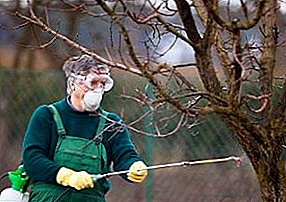 The first spraying is carried out before buds begin to swell in fruit trees and shrubs.
The first spraying is carried out before buds begin to swell in fruit trees and shrubs.- The second is carried out at the moment when the kidneys are actively swelling.
- It is recommended to carry out the third spraying before flowering, but when the flower buds are formed and is about to open.
- The fourth (final processing) is made immediately after the plant has flown.
Features of processing the garden in early spring
The very first garden treatment is considered perhaps the most important. It is better to destroy preventively pests and carriers of diseases that overwinter in the bark and near-ground soil before they came to their senses after hibernation and began their dirty work.
The snow has come down, the temperature has crossed the zero mark, it turned out to be a windless day - and get to work!
What we spray trees in spring before bud break, we already know: we use pesticides, the aggressiveness of which is not yet terrible for the tree, but is deadly for pests.
 Bordeaux liquid for the first spraying use in concentrations up to 3%. You can buy a ready-made kit with correctly selected components, and you can make the drug yourself by mixing 0.45 kg of lime and 0.3 kg of copper sulphate in a bucket of water (10 l).
Bordeaux liquid for the first spraying use in concentrations up to 3%. You can buy a ready-made kit with correctly selected components, and you can make the drug yourself by mixing 0.45 kg of lime and 0.3 kg of copper sulphate in a bucket of water (10 l).
You can also spray trees with Nitrofen or a mixture of urea and copper sulfate (0.7 kg and 0.05 kg, respectively, in a bucket of water). Instead of urea, some gardeners use nitrogen or potash fertilizers, but not chlorine-containing ones. In any case, fertilizer should be used immediately after its breeding, otherwise it will lose all its effectiveness.
Treating trees and shrubs should be completely - from the trunk (especially in places of cracks) and tree trunks to the tips of the branches. Before spraying, be sure to thoroughly clean the barrel with a brush.
In addition, you need to keep in mind that different plants wake up after winter is not at the same time, so if you tighten with the first treatment, especially early trees and shrubs can be burned. So, if apples, pears and plums are sprayed in mid-March, then, say, black currant can have a growing season earlier. Accordingly, it is better to divide the procedure into several stages than to try to catch in one day and as a result rinse the young buds with poison.
Spraying trees and bushes before flowering
As it was said, before the beginning of flowering, after the buds swell, and also right on the buds (before they bloom), the garden is re-treated. If spraying is carried out with pesticides, their weaker concentration should be used (for example, if we diluted the Bordeaux liquid with a 3% solution during the first treatment, now we use 1% solution).
However, it is preferable at this stage to use more modern products that can be purchased in specialized stores. For example, by mixing the fungicide "Chorus" and the insecticide "Aktar", you simultaneously protect the garden from fungal diseases and from pests. The same mixture can be reapplied after flowering trees. Such drugs as "Fufanon", "Decis", etc. have proven themselves well.
The nuances of garden processing during flowering
The question “Is it possible to spray trees during flowering?” Is quite controversial. Many gardeners categorically do not recommend this, because it is possible to damage the inflorescences and disrupt the entire subsequent process of fruit set.
In general, there is no doubt that during the flowering period it is impossible to apply potent pesticides that can harm not only flowers, but also bees that are actively “working” in a flowering garden.
 If for one reason or another you did not have time to process the garden before the appearance of flowers, it is still better later than never. Processing of the garden during this period will protect the tree from aphids, ticks, leafworms, creepers, sawflies and other pests, as well as from many insidious diseases. Phosphorus-containing organic preparations can be used, for example, Fufanon or Actellic. In a warmer time, use "Fitoverm", "Akarin", "Iskra Bio", "Entobacterin" and other biological products, because we remember that they are safe for the tree, but deadly for pathogens of infections and harmful insects.
If for one reason or another you did not have time to process the garden before the appearance of flowers, it is still better later than never. Processing of the garden during this period will protect the tree from aphids, ticks, leafworms, creepers, sawflies and other pests, as well as from many insidious diseases. Phosphorus-containing organic preparations can be used, for example, Fufanon or Actellic. In a warmer time, use "Fitoverm", "Akarin", "Iskra Bio", "Entobacterin" and other biological products, because we remember that they are safe for the tree, but deadly for pathogens of infections and harmful insects.
Treating trees and shrubs after flowering
Spraying fruit trees and shrubs after flowering is the final stage of spring garden protection from diseases and pests.. Its main goal is to destroy the caterpillars of the moth, codling moth, weevils, moths, aphids, ticks and to prevent possible diseases of the garden.
Processing should be carried out no later than three weeks after the trees and shrubs fade.
There is a mass of modern preparations for processing the garden during this period, so there should be no problems with the choice of the most suitable one. But what exactly is not worth spraying the trees after flowering, so it is pesticides in high concentration. It is better at this stage to give preference to biologics or more gentle chemical agents. For the May spraying of fruit trees, for example, you can use the following drugs: Brunka, Blue Bordeaux, Fital, Delan, Saprol, Fury, Fastak, Talstar, Fufanon, "Decis", "Karate", "Confidor", "Aperkot", "Koragen".
 The "Skor" fungicide recommended for use at this stage is also effective and of low toxicity. The choice depends on many factors, in particular, each drug is aimed at combating certain pests, which, in turn, have their own preferences among fruit trees. Therefore, read the instructions and select the optimal mixture.
The "Skor" fungicide recommended for use at this stage is also effective and of low toxicity. The choice depends on many factors, in particular, each drug is aimed at combating certain pests, which, in turn, have their own preferences among fruit trees. Therefore, read the instructions and select the optimal mixture.
So, for example, for an apricot, the greatest danger is perforated spotting and monilial burn, from pests - aphid, leafworm, moth.
Peach, blooming, is often affected by the curvature of foliage and blooming, and it is often attacked by the pinworm. Plum trees are susceptible to moniliosis, klyasterosporosis, and polystygosis, among insects their main enemies are ticks, aphids, leafworms, seed moths. Cherry and cherry orchards after flowering can infect bloom and coccomycosis. Cherry flies love to lay eggs under the peel of the fruit at the time of their setting, and these trees also infect aphids and moths.
Apple trees and pears suffer from scab and powdery mildew, from pests for them the codling mite, mites, aphids, and sawflies are dangerous.
Important! At this stage it is better to sprinkle the garden in the evening: the caterpillars hiding in the foliage choose the ovaries and green mass to eat at night, on which poison is waiting for them. If the drug has worked, in the morning you will be able to observe a mass phenomenon: a huge number of dead caterpillars hanging from the branches on thin cobwebs.
How to handle trees and shrubs from diseases and pests
By and large, you can act as you like, but for safety (yours and those around you), as well as to achieve maximum effect, it is better to follow certain rules and recommendations.
It is necessary to begin spraying from krone, gradually moving down. The final stage is the processing of the wheel circle (it is very important not to forget this section). With the exception of the last spraying, which is carried out during the period of active “work” of the caterpillars, it is better to treat the trees from early morning.
For the procedure you need to choose windless dry day. Ask about the weather forecast and if rain is foreseen in the next day, postpone the procedure for several days. With minimal moisture, the active substance absorbs faster and causes less damage to the plant. An exception may be some biological products, which, on the contrary, require the presence of moisture, so before using them, read the instructions. It is also important to correctly calculate the required amount of the drug, since its reuse after some time is absolutely unacceptable: you need to dissolve exactly as much as you need for today's treatment. It follows from this calculation: about 5-6 l of the solution “leaves” for an adult tree, 0.5 to 1.5 l for shrubs and young trees, depending on their size.
Finally, in order to work comfortably, you should not put a broom in a bucket and splash it on a tree — buy a modern sprayer better. Today, manufacturers offer the broadest selection of models that will allow you to choose the best option depending on the size of your garden (they differ in both volume and power, well, and, accordingly, in price). Low-growing trees and young saplings can be treated with an ordinary plastic sprayer, and for large gardens it may be worth buying an expensive but very reliable electric pump.
Do not forget about the technique of personal safety. It is necessary to clearly understand how toxic the drug with which you work and, depending on this, to correct your behavior. In any case, the face should be covered with a respirator or gauze bandage, the hair should be covered with a kerchief or bandana, and eyes protected with glasses. Wear gloves and it is generally better not to leave open skin. Keep households (especially children) and pets away.
Spring garden processing is a difficult process, requiring considerable labor and financial costs, as well as sufficiently deep knowledge of agricultural engineering. And yet you can’t do without it, of course, if you are counting on the long life of the trees or shrubs you plant and you want to harvest a decent harvest each year.


 The first spraying is carried out before buds begin to swell in fruit trees and shrubs.
The first spraying is carried out before buds begin to swell in fruit trees and shrubs.